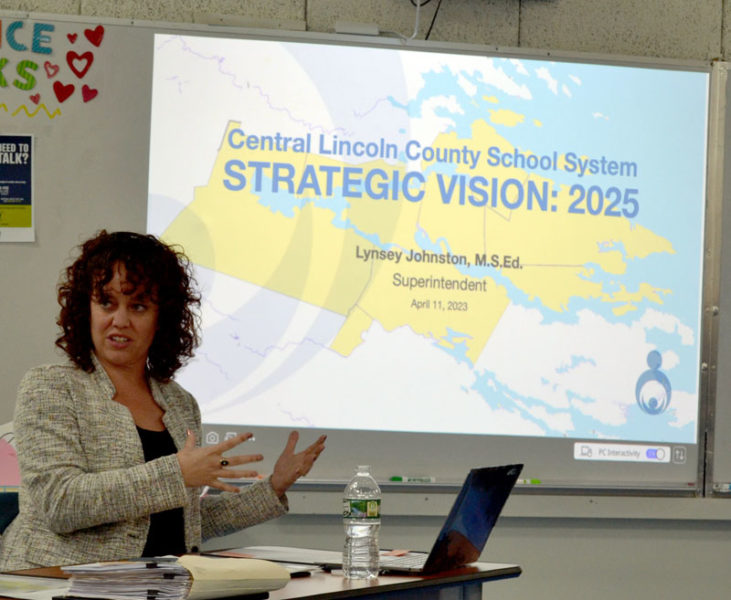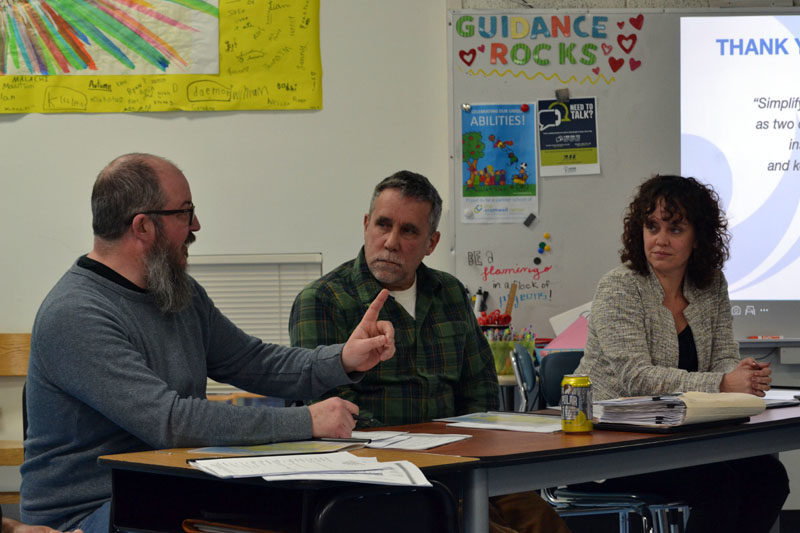
Superintendent Lynsey Johnston discusses a proposal for the district’s strategic vision at the AOS 93 Board meeting on Tuesday, April 11 at Bristol Consolidated School. (Maia Zewert photo)
Administrators in the Central Lincoln County School System have proposed the exploration of a comprehensive restructuring of the district in an effort to reduce inefficiencies and inconsistencies.
Superintendent Lynsey Johnston presented the proposal to the AOS 93 School Board during its meeting at Bristol Consolidated School on Tuesday, April 11. An automated email containing the complete strategic plan document was sent to faculty and staff members in the district during Johnston’s presentation, and the document was made available on the district’s website.
AOS 93 serves seven towns – Bremen, Bristol, Damariscotta, Jefferson, Newcastle, and Nobleboro – and contains five schools – Bristol Consolidated School, Great Salt Bay Community School, Jefferson Village School, Nobleboro Central School, and South Bristol School.
All schools and towns share many of the same problems and concerns, including staffing issues, meeting behavioral needs of students, and rising costs, Johnston said. Each town has a school committee, and with the addition of the Great Salt Bay School Committee and the AOS 93 Board, “everything we do, we do nine times,” Johnston said.
The conversation about what could be done to improve efficiencies while continuing to provide a high standard of education to the community began in earnest earlier this year between administrators in the central office and at the five schools. The proposal presented at the April 11 meeting is in no way set in stone, Johnston said, and is rather meant to start the conversation that other AOS districts have had in recent years.
“We’re not alone in this, it is a common conversation,” Johnston said.
The vision includes keeping all school buildings open and in operation and does not call for a reduction in staff, Johnston said.
Potential educational benefits outlined in the proposal include the localization of programs for students with special needs, behavioral intervention resources more equitably distributed among the schools, and the possibility to expand pre-K programs to reach more students. There could be potential for smaller, more centralized regional programming as well.
At the municipal level, redistricting could prevent the escalation of per-pupil costs to towns, help mitigate fluctuating enrollment, and address long-range facilities needs through regional collaboration, according to the presentation.
The reduction of redundancies would allow building principals to focus on staff and program management, rather than spreading themselves thin over handling operations and help retain talented valuable and effective personnel, Johnston said.
Possible scenarios were presented to the board to demonstrate what the end result of redistricting could look like, however, the community will have the final say, Johnston said.
“If a town doesn’t want to do this, they don’t have to,” Johnston said. “Any one of the boards can choose not to do this. It won’t limit any other town from another town’s choice.”
The proposal includes four phases of exploration, the legal process of redistricting through the Maine Department of Education, community involvement through public hearings, forums, town meetings, and ultimately voter approval. The entire process would take at least two years to complete, and could be in place by the beginning of the 2025-2026 school year.
“I don’t want anyone to think this is a quick process,” Johnston said. “It will take a lot of time and effort.”
While the board did not take official action on the presentation, members expressed a consensus of support for the idea.
“This is great to see … opening the door for the various communities to think about this,” Jesse Butler, Newcastle’s representative on the board, said. “Even if nothing changes, people will learn things.”
Johnston will present the strategic vision at school committee meetings in May, at which point she will ask for a vote to give her the authority to hire an attorney from Portland-based Drummond Woodsum to help guide the district through the process.
“We encourage you to go to all of the individual boards and have this conversation,” Chair Matthew Hanly said.
To read the plan, go to aos93.org/page/strategic-vision-2025.

From left: Jesse Butler, Newcastle’s representative on the AOS 93 Board, talks about the potential outcomes of redistricting as board Chair Matthew Hanly and Superintendent Lynsey Johnston listen during a meeting at Bristol Consolidated School on Tuesday, April 11. (Maia Zewert photo)






